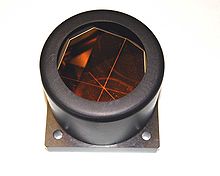Retroreflectivity

A gold corner cube retroreflector
|
|
| Uses | Distance measurement by optical delay line |
|---|---|
A retroreflector (sometimes called a retroflector or cataphote) is a device or surface that reflects light back to its source with a minimum of scattering. In a retroreflector an electromagnetic wavefront is reflected back along a vector that is parallel to but opposite in direction from the wave's source. The angle of incidence at which the device or surface reflects light in this way is greater than zero, unlike a planar mirror, which does this only if the mirror is exactly perpendicular to the wave front, having a zero angle of incidence.
There are several ways to obtain retroreflection:
A set of three mutually perpendicular reflective surfaces, placed to form the corner of a cube, work as a retroreflector. The three corresponding normal vectors of the corner's sides form a basis (x, y, z) in which to represent the direction of an arbitrary incoming ray, [a, b, c]. When the ray reflects from the first side, say x, the ray's x-component, a, is reversed to −a, while the y- and z-components are unchanged. Therefore, as the ray reflects first from side x then side y and finally from side z the ray direction goes from [a, b, c] to [−a, b, c] to [−a, −b, c] to [−a, −b, −c] and it leaves the corner with all three components of its direction exactly reversed.
Corner reflectors occur in two varieties. In the more common form, the corner is literally the truncated corner of a cube of transparent material such as conventional optical glass. In this structure, the reflection is achieved either by total internal reflection or silvering of the outer cube surfaces. The second form uses mutually perpendicular flat mirrors bracketing an air space. These two types have similar optical properties.
A large relatively thin retroreflector can be formed by combining many small corner reflectors, using the standard hexagonal tiling.
...
Wikipedia
